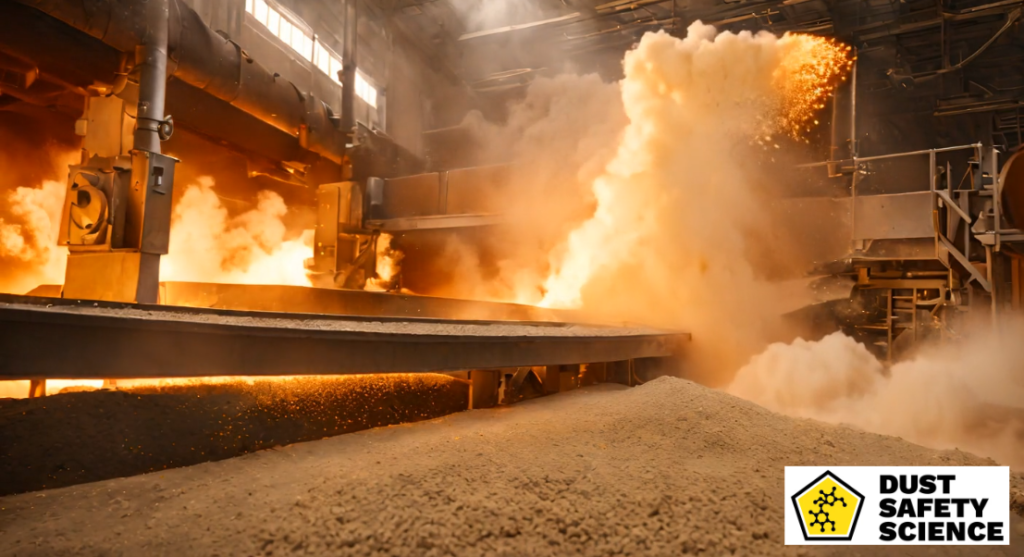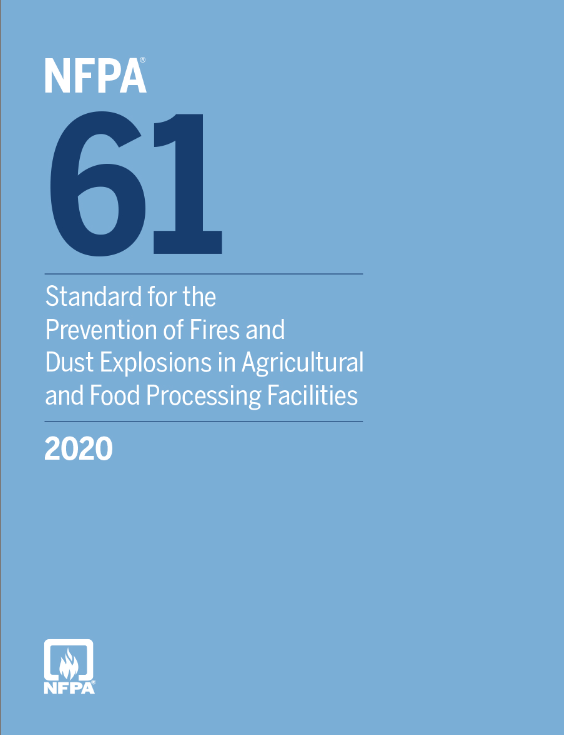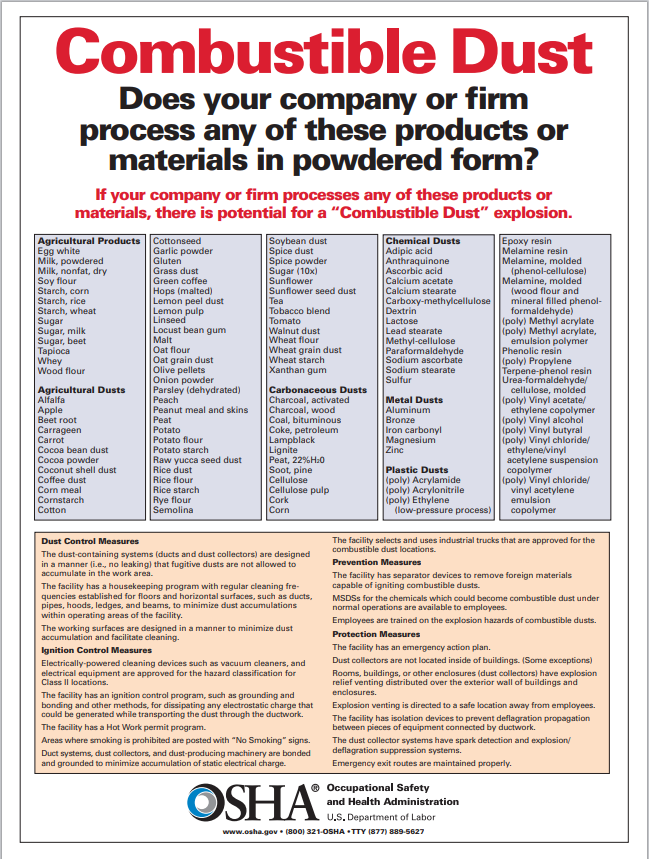Update December 9, 2024 Authored by Dr. Chris Cloney and Jon Barrett of Dust Safety Science

Introduction to Grain Explosions
Grain handling is a cornerstone of both agriculture and food industries, serving as the initial step in processing grains like wheat, oats, barley, and more. However, this essential process includes hazards, chief among them being grain dust explosions. An average of 10.6 agricultural grain dust explosions are reported per year in the U.S. resulting in 1.6 deaths, 12.6 injuries, and millions of dollars in damages (Schoeff, 2006). Understanding the dynamics of an explosion is crucial for ensuring the safety of workers, the integrity of facilities, how these grain dust explosions occurred, and the sustainability of the entire grain handling sector.
In the grain and agriculture industry, the presence of combustible dust represents a significant peril. This grain dust and fine particulate matter is often a byproduct of processing and handling grains or agricultural materials like wheat, corn, barley, and rice, and is inherently combustible. The nature of these materials, when finely ground, such as flour, metal, wood, and coal dust, during various processing stages or stored in silos, including a confined space, or a grain elevator, elevates the risk of accumulation of dust, dust clouds, and secondary dust explosions. These particles, when suspended in the air in certain concentrations, as a dust cloud, can ignite swiftly when exposed to an ignition source, triggering dust explosions or fires and secondary dust explosions, with devastating consequences. This dust, composed of organic materials, possesses the potential for rapid combustion when exposed to ignition sources, setting the stage for combustible dust explosions, secondary dust explosions, or fires within grain processing facilities, silos, a grain elevator, or storage areas.
The fine, granular composition of these materials facilitates the dispersion and suspension of dust particles, and particulate accumulation, increasing the likelihood of dust clouds and their interaction with ignition sources such as electrical equipment, friction, sparks, or even static electricity, causing grain dust explosions. As grains are processed and handled—whether through milling, grinding, conveying, a grain elevator, or storage—a considerable amount of dust is produced. This dust, when allowed to accumulate, creates dust clouds, and an environment ripe for disaster and grain dust explosions. For a dust explosion to occur, five conditions are required concurrently, as the dust explosion pentagon. Factors like particle size, concentration in the air, and the presence of oxygen contribute to the combustibility of this dust, emphasizing the critical need for stringent safety protocols and dust explosion protection methods, from dust clouds, grain dust explosions, and secondary dust explosions.

Grain Explosions Causes
Grain explosions are rapid combustion reactions fueled by the ignition of suspended particles in the air. These grain explosions occur when finely ground particles of grain dust, typically generated during handling and processing operations, become suspended in the air at concentrations within a specific range known as the minimum explosive concentration (MEC). When an ignition source, such as a spark or flame from a grain elevator, comes into contact with this combustible dust cloud, it can result in a devastating explosion. According to OSHA, there are five conditions to meet to have dust explosions, they are oxygen, heat, fuel, dispersion, and confinement. These five factors make up what is known as the Dust Explosion Pentagon. The five conditions of the Dust Explosion Pentagon can create a catastrophic incident.
Historically, grain dust explosions have caused significant damage and loss of life. One of the most infamous examples is the explosion at the DeBruce Grain elevator in Kansas in 1998, where six workers lost their lives due to a massive blast triggered by the ignition of grain dust. Over the past decade, an average of 7.8 agricultural grain dust explosions were reported per year in the United States, according to statistics from Purdue University. Such incidents underscore the urgent need for preventive measures and safety protocols in grain facilities, to prevent a grain elevator explosion, such as the Murray Grain Elevator Explosion of 1919, and to understand how a grain elevator explosion occurs, within grain elevators.

Dust Explosions and Facility Damage
A Grain explosion pose immediate and long-term risks to health, safety, and the environment. In the immediate aftermath of a primary explosion, workers may suffer from burns, trauma, and respiratory issues due to exposure to flames, pressure waves, and toxic gases. Moreover, the structural damage caused by secondary explosions in a grain handling facility, can result in collapsed buildings and machinery, leading to severe injuries and fatalities.
Beyond the human toll, an explosion may also have significant economic repercussions. Businesses incur losses from property damage, equipment destruction, and production disruptions. The agriculture sector as a whole may experience decreased productivity and increased insurance premiums, from grain dust explosions, affecting farmers, processors, and distributors alike.
Furthermore, grain explosions can have adverse environmental consequences, including air and water pollution. The release of combustion byproducts and toxic gases into the atmosphere from grain dust explosions, can harm ecosystems and pose risks to occupational safety and health.
Grain Facilities Risks
Grain facilities are inherently susceptible to accumulation of dust, and a grain dust explosion given the nature of their operations. Common sources of grain dust include grain transfer points, grain elevators, bucket elevators, an enclosed and confined space, and enclosed conveyors. Additionally, poor ventilation systems and inadequate housekeeping practices can exacerbate dust buildup, increasing the likelihood of a grain dust explosion, and a grain elevator explosion.
To mitigate these grain dust explosions and risks, facility managers must implement rigorous housekeeping procedures and sanitation programs to minimize particulate accumulation. Regular inspections of equipment and machinery are essential to ensure compliance with the bearing manufacturer’s specifications and to identify potential ignition sources, to prevent grain dust explosions and secondary dust explosions.
Preventive Measures
Preventing a grain dust explosion requires a multifaceted approach that encompasses dust control strategies, safe handling practices, and emergency preparedness. Ventilation systems play a crucial role in maintaining dust levels below the MEC, thereby reducing the risk of explosions. Additionally, implementing cleaning routines and dust suppression methods can help minimize grain dust accumulation in enclosed spaces.
Safe grain handling practices, such as minimizing the generation of dust during loading and unloading operations, are essential for preventing a grain elevator and bucket elevator explosion. According to the Oklahoma State University Extension, some preventive measures include replacing steel cups with plastic cups in elevator legs and using anti-static belting material in legs and horizontal belt conveyors. Install belt rub sensors inside bucket elevator leg casings to detect belt misalignment to prevent friction heating. Maintain a rigorous housekeeping program inside the grain elevator structure. Employees should receive comprehensive training on the hazards of grain dust and proper safety protocols. Preventing dust explosions, such as the primary and secondary explosions, from small dust particles and dust clouds, in a bucket elevator, grain elevators, and confined spaces, should be a priority. Furthermore, establishing emergency response plans and conducting regular drills can ensure swift and effective responses in the event of an explosion.
Guidelines and Standards
Regulatory agencies and industry bodies play a vital role in establishing and enforcing safety standards for grain handling facilities. Compliance with these regulations is essential for preventing explosions and protecting workers’ safety. Organizations such as the National Grain and Feed Association (NGFA) provide guidelines and resources to help facilities adhere to best practices in dust control and safety management.
Hazardous Dust is a serious workplace hazard that can lead to catastrophic incidents if not properly managed. To mitigate the risks associated with hazardous dust, various standards and regulations have been put in place. In the year 1923, was when the NFPA published the first standard on combustible dust, as no national regulations were enacted to address the problem of combustible dust directly, and dust-related explosions and fires, along with loss of life and property, continued to occur. Listed are the important dust standards and regulations, and why they are crucial for the safety of workers and the prevention of industrial disasters:
- NFPA 61, Standard for the Prevention of Fires and Dust Explosions in Agricultural and Food Processing Facilities NFPA 61 protects lives and property from fires and explosions in facilities handling, processing, or storing bulk agricultural materials, their by-products, or other agricultural related dust and materials.
- NFPA 68, Standard on Explosion Protection by Deflagration Venting applies to the design, location, installation, maintenance, and use of devices and systems that vent the combustion gases and pressures resulting from a deflagration within an enclosure so that structural and mechanical damage is minimized. Chapter 8 of the NFPA 68 provides guidance on Venting of Deflagrations of Dusts and Hybrid Mixtures, Effects of Vent Ducts, Bins, Hoppers, and Silos, Venting of Dust Collectors Using Bags, Filters, or Cartridges, Bucket Elevators, Venting Internal to Building with Flame-Arresting and Particulate Retention Device, Venting Silos or Other Storage Vessel Provided with Integral Bin Vents, and Deflagration Venting of Enclosures Interconnected with Pipelines.
- NFPA 654 Standard for the Prevention of Fire and Dust Explosions from the Manufacturing, Processing, and Handling of Combustible Particulate Solids. The NFPA 654 Standard is referenced by OSHA’s Combustible Dust National Emphasis Program (NEP) to identify dust hazards and define mitigation strategies that help protect life and property. The standard provides industry-recognized safety practices for facility and systems design, process equipment protection, fugitive dust control and housekeeping, ignition source identification and control, fire protection, training and procedures, inspection, and maintenance.
Innovations in Dust Explosion Prevention
Advancements in technology offer promising solutions for mitigating the risks of a grain dust explosion. Dust detection systems and dust explosion protection methods can provide early warning of potential hazards, allowing operators to take corrective actions before an explosion occurs, and how the dust explosions occurred. For a dust explosion to occur, five conditions are required concurrently, as the dust explosion pentagon, and technology can assist in the prevention of dust explosions. Furthermore, innovations in dust control equipment, such as dust aspiration systems, help remove suspended dust particles from the air, reducing the likelihood of a dust cloud forming from ignition and increasing dust explosion prevention and occupational safety and health.
Looking ahead, emerging trends in grain handling safety focus on enhancing automation and remote monitoring capabilities to minimize human exposure to hazardous environments. By integrating cutting-edge technologies and adopting proactive risk management strategies, the industry can move towards a safer and more sustainable future.

Conclusion
Grain dust explosions represent a significant threat to the safety of workers, the integrity of facilities, and the stability of the agriculture sector. Understanding the causes and consequences of why these dust explosions occurred is paramount for implementing effective preventive measures and safety practices. Eliminating one of the five conditions to have an explosion, known as the Dust Explosion Pentagon, is important for education and training. By prioritizing dust control, preventing a dust cloud, implementing dust explosion protection methods, adhering to regulatory standards, and embracing technological innovations, grain facilities can minimize the risk of grain explosions and protect the well-being of their employees and communities. Continuous improvement in safety practices with dust explosion prevention and ensuring compliance with industry regulations, electrical equipment, occupational safety and health, and to prevent the devastating impact of grain dust explosions.
About Dust Safety Science
For more from Dr. Chris Cloney on Combustible in the Grain and Agriculture Industry, visit this podcast episode: Incident Update – 2023 Grain Dust Explosion in Decatur, Illinois

Resources:
Visit: Dust Safety Science’s Training Page
Visit: Latin America Dust Explosion Safety and Dust Hazard Analysis Demystified Online Training
Visit Dust Safety Science (Global Incident Tracking)
Visit Dust Safety Academy (Resources, Training, and Events)
Visit Dust Safety Professionals (Need Help? Get Support Today!)
Visit Dust Safety Journal for the Complimentary, Dust Safety Science Monthly Journal
Subscribe to our Complimentary, Dust Safety Science Newsletter at Dust Safety Science Newsletter
Visit the Dust Safety Science blog for written articles on combustible dust safety including the latest research, expert opinions, and state-of-the-art in fire and explosion protection.
